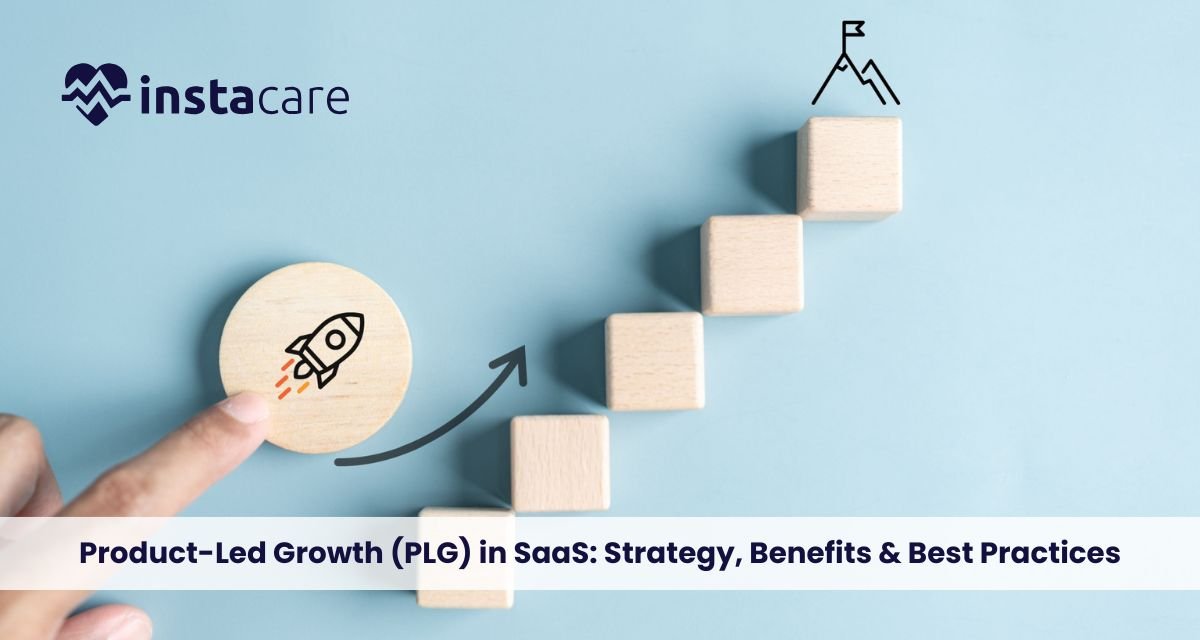Last updated on Thursday, 27, November, 2025
Table of Contents
Product-Led Growth (PLG) in SaaS: Strategy, Benefits & Best Practices
In the fast-changing and competitive SaaS landscape of today, Product-Led Growth (PLG) is now among the most successful ways of scaling SaaS companies. Compared to traditional paradigms of marketing and sales, PLG trusts in enabling the product itself to be responsible for user acquisition, retention, and expansion. By doing this, the process puts the product experience at the center of the customer journey, and it results in more natural and scalable growth.
This guide explores what PLG is, why SaaS cares about it, its basic building blocks, most popular benefits, and best practices to make it successful.
What is Product-Led Growth (PLG)?
Product-Led Growth (PLG) refers to a business strategy where the product itself is the key driver of customer acquisition, activation, and retention. In a PLG model, users self-discover and start using a product themselves, typically through a freemium in PLG or trial, isolated from contacting sales or support teams.
This is a reversal of the old funnel. Instead of sales or marketing efforts first, users experience the value of the product directly. It’s a bottom-up strategy with an emphasis on a user experience that effortlessly turns free users into paid customers.
One famous product-led growth example is Slack, which was broadly adopted through its clean design, easy onboarding, and ability to solve communications pain points directly without needing a long sales pitch.
Why PLG Matters in SaaS?
SaaS companies exist on scale, automation, and retention. PLG just perfectly fits these needs. Traditional go-to-market strategies outsourced sales and expensive marketing may struggle to keep pace with the expectations of current B2B and B2C buyers. They would rather “try before they buy,” educate themselves, and self-onboard.
This is where PLG shines. It allows users to learn the product value upfront, with more control and confidence. Contrast product-led vs sales-led growth, PLG offers a less expensive and more scalable path, especially for companies targeting global markets or SMBs with low contract value.
Core Elements of a PLG Strategy
To build a successful PLG motion, SaaS companies need to be sensitive to several fundamental building blocks:
1. Frictionless Onboarding
A successful PLG onboarding experience allows customers to learn and gain access to the core value of the product in an instant. Think guided tours, templates, interactive walkthroughs, and contextual tips that reduce time to value (TTV).
2. Self-Serve Infrastructure
One of the basic foundations of the self-serve SaaS model, it is about allowing customers to sign up, upgrade, bill, and even cancel without ever having to talk to sales or support. One of the most significant considerations for reducing customer acquisition cost (CAC) and maximizing scalability.
3. User Activation
User activation in PLG is the moment when a user receives a beneficial consequence from the product. Activation matters since that’s where the periodic user is turned into a potential long-term customer. Activation metrics help in bringing forth friction points in the user experience.
4. Product Qualified Leads (PQLs)
Product qualified leads (PQLs) are users who have experienced notable product value and are very likely to be paying customers. Unlike regular MQLs or SQLs, PQLs are based on usage patterns and in-product signals.
5. PLG Metrics
Track the appropriate product-led growth metrics to refine your strategy. These are activation rate, time to value, expansion revenue, product engagement score, churn rate, and PQL conversion rate.
Book Your Free Marketing Consultation
Benefits of Product-Led Growth
Embracing PLG releases numerous strategic advantages for SaaS businesses:
● Lower Customer Acquisition Costs
Since users can onboard themselves and experience the product without any direct intervention from sales, CAC declines significantly.
● Lower Time-to-Value (TTV)
By making it easy for users to view immediately how the product can help them, PLG makes the adoption period shorter from sign-up.
● Higher Retention and Expansion
Heavy users are more likely to stick around, add on features, and upgrade plans.
● Scalability
PLG makes it possible to onboard thousands (millions) of users simultaneously without requiring proportional sales efforts, and it’s ideal for explosive growth.
● Improved Customer Experience
PLG places the power in the user’s hand, allowing them to find out, experiment with, and purchase on actual product experience. This results in increased satisfaction and trust.
The following are only a few of the benefits of product-led growth, but collectively, they can be a gigantic competitive advantage for SaaS companies today.
Best Practices for Implementing PLG in SaaS
To successfully convert or launch with a PLG motion, remember the following tested and proven best practices:
● Design for the End User
Create product features and design for what the end customer needs, not just the buyer persona. This fosters adoption and advocacy on the grassroots level, subsequently influencing top-down buying decisions.
● Simplify Sign-Up and Onboarding
Use one-click sign-ups, minimize unnecessary form fields, and get users to their “aha moment” as quickly as possible. A strong PLG and onboarding experience is essential in locking value early.
● Leverage Freemium or Free Trials
Afreemium model in PLG allows users to learn about the product without friction. Make your free version provide real value, but holds back enough premium features to necessitate a step up.
● Measure and Refine PLG Metrics
Track each touchpoint from onboarding to feature adoption to locate where users drop off and what drives activation. Use product-led growth metrics to refine and tailor user experiences.
● Enable Viral Loops and Referrals
Attributes such as “invite a team member” or “share a report” enable users to proliferate the product within and between organizations, fueling organic growth.
● Bring Teams Together Around the Product
PLG necessitates cooperation between product, marketing, sales, and customer success. Everyone needs to be aligned on common metrics, e.g., PQLs and activation rates.
● Create SaaS Growth Strategies Around Usage
Different from traditional strategies that focus on campaigns and leads, SaaS growth tactics for PLG are built around driving growth, engagement, and usage from within the product.
● Augment with Sales Where Needed
PLG doesn’t necessarily mean phasing out sales. Enterprise accounts or advanced use cases are best addressed by a hybrid. Sales teams can focus on high-value users already activated through the product.
Conclusion
PLG has become the disruptor for the SaaS industry, allowing companies to grow faster, be cost-effective, and deliver better customer experiences. By putting the product center stage of the growth engine, SaaS companies can capitalize on a more grassroots, user-driven model of expansion.
Understanding how product-led growth works is vital not just for marketers and product managers, but for any SaaS leader who wants to achieve lasting, long-term success. If you’re launching a new product or shifting from a sales-led model, the PLG framework provides you with a roadmap to faster growth and deeper user interaction.
In PLG, compared to traditional marketing, the cost savings, scalability, and customer delight are self-evident. The right foundation activation, metrics, and user experience are paramount, and PLG can scale growth that is not possible for traditional models.
FAQs
1. What types of businesses realize the most value in PLG?
PLG is most apt for scalable, user-centric products of SaaS businesses, especially those with large audiences or SMBs. Enterprise SaaS, however, also stands to benefit from using PLG for the adoption process leading up to sales engagement.
2. Where does PLG differ from normal sales paradigms?
In traditional sales models, revenue growth is driven by marketing and sales organizations. In PLG, growth is driven by the product through delivering users a direct and frictionless path to adoption and expansion.
3. Are there any examples of PLG SaaS companies?
Examples of PLG SaaS companies include Zoom, Dropbox, Canna, Slack, and Notion. These platforms offer simple-to-use UX, self-serve models, and clearly defined values that attract and retain customers without requiring heavy outbound sales.



